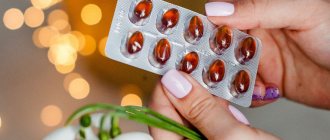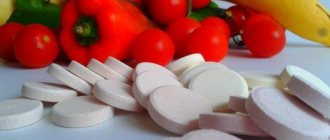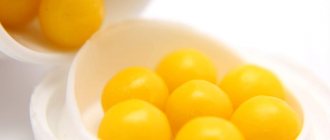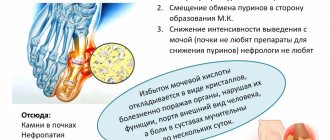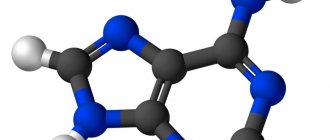Historical information
The history of the antipellagric vitamin is perhaps one of the most fascinating and complex.
Back in 1867, Huber first obtained nicotinic acid by oxidizing nicotine with chromic acid, but only in 1937 was it proven that it is vitamin PP. In 1873 Weidel. obtained nicotinic acid by oxidation of nicotine with nitric acid, and in 1879 by oxidation of beta-picoline. He also suggested its name. At the same time, in 1879, the Russian organic chemist A. N. Vyshnegradsky synthesized nicotinic acid from 3-ethylpyridine. In 1877 Laiblin obtained nicotinic acid by oxidizing nicotine with permanganate. In 1912 Suzuki, Shimamura and Odake isolated nicotinic acid from rice bran, and in 1913, independently of them, Funk isolated it from rice bran and yeast. However, the isolated crystalline substance did not prevent or cure beriberi. In 1926, Vickery again isolated nicotinic acid from yeast. But none of the listed researchers suspected that this substance was a true antipellagric factor. This is even more surprising because around the same time, the American doctor Goldberger identified as the main cause of pellagra a deficiency in human nutrition of a new, hitherto unknown factor PP (pellagra preventing). He tried to make rats deficient in this substance. However, the cause of the disturbances he obtained in the experiment was subsequently found to be vitamin B6 deficiency.
In 1935, V.V. Efremov showed that vitamin B6 does not cure experimental pellagra in dogs.
In 1936, Koehn and Elvehjem found that liver extract did not prevent or cure canine pellagra or pellagra in humans.
In 1936, they obtained an active fraction from liver extract, 64 mg of which cured canine pellagra. From this fraction in 1937, Strong and Woolley obtained a crystalline substance, which turned out to be nicotinic acid.
In 1937, Elvehjem and co-authors established in experiments on dogs in which experimental pellagra was reproduced that nicotinic acid cures this disease. In 1937, nicotinic acid was successfully used for human pellagra.
In 1938, V.V. Efremov, for the first time in the USSR, cured severe pellagra with psychosis with nicotinic acid.
In the course of their search to uncover the etiology of pellagra, Goldberger and Tanner in 1922 hypothesized that the cause of this disease could be a lack of certain amino acids, namely tryptophan, which was later confirmed.
Warburg and Christian in 1934 first showed the importance of nicotinic acid in biochemical reactions. They isolated nicotinic acid amide from codehydrase II (NADP) and established its function as a constituent of the hydrogen transfer coenzyme. Almost simultaneously, in 1935, Euler et al. isolated a substance from codehydrase I (NAD), which was also identified with nicotinic acid amide. The great biological significance of nicotinic acid was then established by a number of studies showing that this substance is an important factor for some microorganisms.
Nicotinic acid (vitamin B3)[edit | edit code]
Historical background[edit | edit code]
In countries with high corn consumption, especially Italy and North America, a disease called pellagra (from the Italian relie agra, “rough skin”) has been known for centuries. In 1914, Funk postulated a connection between this disease and a deficiency of some nutrients. A few years later, Goldberger et al. showed that pellagra can be prevented by adding fresh meat, eggs and milk to the diet. Subsequently, Goldberger created an excellent experimental model of pellagra (“black tongue”) by keeping dogs on an inadequate diet. Pellagra was initially thought to be caused by a deficiency of essential amino acids, but it was soon shown that the disease was prevented by one of the heat-stable factors present in water-soluble B vitamin preparations.
In 1935, Warburg et al. Nicotinic acid amide (nicotinamide) was obtained from a coenzyme isolated from horse erythrocytes. This has drawn attention to the role of niacin in nutrition. Since it was known that pellagra in humans and “black tongue” in dogs can be cured with liver extracts, in 1937 Elveheim, analyzing such extracts, discovered nicotinamide in them and showed that it was responsible for the therapeutic effect. Then it was found that synthetic derivatives of nicotinic acid have a similar effect. Even earlier, Goldberger and Tanner found that taking tryptophan helps with pellagra. It was later discovered that this was due to the conversion of tryptophan to nicotinic acid. A diet low in niacin and tryptophan caused pellagra in humans (Goldsmith, 1958).
In order not to confuse nicotinic acid with the alkaloid nicotine, it is sometimes also called niacin. Pellagra is now very rare in the United States, probably because niacin has been added to flour since 1939. Structure. In the body, nicotinic acid is converted into NAD or NADP. It is important to note that in both compounds, nicotinic acid is present in the form of nicotinamide. The structural formulas of NAD and NADP are shown below; the letter R in the structure of NAD denotes hydrogen (H), and in the structure of NADP the group P03H2. Analogues of nicotinic acid, which are its antagonists, have been synthesized: pyridine-3-sulfonic acid and 3-acetylpyridine.
Chemical and physical properties of vitamin PP
Nicotinic acid is quite easily isolated from most natural products. It is a white, needle-shaped, odorless, crystalline substance with a sour taste and a melting point of 234-237°. Its molecular weight is 123.11. One gram of nicotinic acid is soluble in 60 ml of water and 80 ml of ethyl alcohol at 25°. It is insoluble in ether, but soluble in aqueous solutions of alkali hydroxides and carbonates. Nicotinic acid is not hygroscopic, very stable in dry form. Its solutions can withstand autoclaving at 120° for 20 minutes without destruction. It tolerates boiling well in 1 N. and 2 n. solutions of mineral acids and alkalis. Nicotinic acid has an absorption spectrum in ultraviolet rays with a maximum at 260-260.5 nm. There is a linear relationship between the absorption coefficients of nicotinic acid and its concentration.
According to its chemical structure, nicotinic acid is beta-pyridinecarboxylic or pyridine-3-carboxylic acid. Nicotinamide is a white, odorless, crystalline powder with a bitter-salty taste. It melts at 129-131° and has a molecular weight of 122.12. One gram is dissolved in 1 ml of water and 1.5 ml of 95% ethyl alcohol. It is soluble in acetone, amyl alcohol, ethylene glycol, chloroform, butanol, and slightly soluble in ether and gasoline. Nicotinamide sharply increases the solubility of riboflavin. When dry, it is very stable at temperatures below 50°. In aqueous solution it can be autoclaved at 120° for 20 minutes without visible loss of activity. Under the influence of acids and alkalis, it turns into nicotinic acid.
Nicotinamide has an absorption maximum at 260-261.5 nm. According to its chemical structure, it is an amide of beta-pyridinecarboxylic or pyridine-3-carboxylic acid.
Nicotinic acid can be obtained from nicotine, from beta-picoline, quinoline, pyridine, etc. Nicotinamide can be obtained from nicotinic acid, its esters and from 3-cyano-pyridine. One of the most important analogues of nicotinic acid is 3-acetylpyridine, which is used in animal experiments to reproduce nicotinic acid deficiency, as is another analogue, 6-aminonicotinamide. 3-Acetylpyridine has almost no effect on healthy dogs, since only a small part of it is converted in the body into nicotinic acid, and the majority is excreted in the urine in the form of nicotinate and other compounds. When it was used in experiments on mice at a dose of 3 mg per day, symptoms of nicotinic acid deficiency appeared after 3-4 days.
The toxicity of 3-acetylpyridine LD50 for mice is 300-350 mg/kg, and for rats - 80 mg/kg. The toxicity of 6-aminonicotinamide (LD50 for mice 35 mg/kg) is significantly higher than that of 3-acetylpyridine. At a dose of 2 mg/kg, 50% of the animals died after 11 days.
Isonicotinic acid hydrazide (isonicotinylhydrazide, isoniazid) inhibits the growth of Mycobacterium tuberculosis, which lose about 50% of NAD at a concentration of isoniazid in the medium of 0.1 μg/ml. Based on this, it is successfully used as a treatment for tuberculosis.
Distribution of vitamin PP in nature
Nicotinic acid is quite widespread in plant and especially animal products, which are much richer in nicotinic acid. Of the plant products, the richest are dry brewer's yeast (40 mg%) and baker's press yeast (28 mg%). A significant amount of nicotinic acid is found in grain products. For example, wheat contains over 5 mg%.
The distribution of nicotinic acid in wheat grain is approximately the same as that of thiamine. It is found predominantly in the outer layer of the endosperm, the germ and the bran, with the difference that the bran contains more nicotinic acid and less thiamine than the germ. Wallpaper flour contains all the nicotinic acid, and bread made from it contains 3.5 mg%, in 1st grade flour – 1 mg%, and in bread made from it – 0.7 mg%. Rye is significantly poorer than wheat in terms of vitamin PP - 1.1 mg%. Rye flour contains 1 mg%, and rye bread contains 0.45 mg% nicotinic acid. Corn contains about 2 mg%.
Of the cereals, the richest in nicotinic acid is buckwheat (over 4 mg%), then millet (over 2 mg%), barley (2 mg%), oatmeal (1.6 mg%), pearl barley (1.5 mg%), polished rice (1.6 mg%), semolina - 0.9 mg%.
In corn, as in most other grain crops, 95-98% of nicotinic acid is in a bound form that is not digestible by the body - an ester of a complex structure (niacitin). It is released completely only after alkaline hydrolysis. Nicotinic acid released by alkaline hydrolysis is easily absorbed by the body of animals and humans. Along with this, grain crops such as corn are very poor in tryptophan. This should be taken into account when assessing the content of niacin in diets.
Among other plant products, good sources are legumes, in which nicotinic acid is in digestible form: green peas, lentils, beans, soybeans (2 - 2.5 mg%). A good source of nicotinic acid is coffee beans, which contain from 2 to 10 mg%, depending on the variety and roasting. Peanuts are very rich in nicotinic acid (10 - 16 mg%), then spinach, tomatoes, cabbage, rutabaga, eggplant (0.5 - 0.7 mg%). Potatoes contain 0.9 mg% (boiled 0.5 mg%), carrots - 1 mg%, sweet peppers - 0.9 mg°/0, turnips - 0.8 mg%, red beets - 1.6 mg%, in fresh mushrooms - 6 mg%, in dried mushrooms - up to 60 mg%.
Animal products are very rich in nicotinic acid, with the exception of eggs (0.2 mg%) and milk (about 0.1 mg%). So poultry meat contains 6-8 mg%, lamb -5.8 mg%, beef -4 mg%, veal - over 6 mg%, pork - about 3 mg%, liver - 15-16 mg%, kidney -12 -15 mg%, heart -6 - 8 mg%. Fish is poorer in nicotinic acid than livestock meat. Fresh fish contains on average about 3 mg% nicotinic acid, frozen cod - about 2 mg%, pike - 3.5 mg%, pike perch - 1.8 mg%.
In animal tissues, almost all nicotinic acid is in the form of amide bound to the nucleotides NAD and NADP. In foods of plant origin, the nicotinamide content ranges from 7% (yellow corn) to 70% (potatoes) relative to total niacin. In most products of plant origin, nicotinic acid is distributed mainly in the outer shells. For example, wheat bran contains 330 mcg per 1 g, premium wheat flour - 12 mcg, whole wheat - 70 mcg, polished rice - 0.9 mcg, unpolished rice - 6.9 mcg, rice bran - 96.6 mcg, etc. d.
Nicotinic acid is one of the most stable vitamins in terms of storage and cooking. It is also very resistant to canning processes. In canned food stored for 2 years, its loss does not exceed 15%. There is virtually no loss during freezing or drying. Conventional cooking methods result in losses of 15 to 20% of activity. With some cooking methods, losses reach up to 50%. The composition of the soil can affect the content of niacin in plants. A decrease in the content of major ions in nutrient solutions reduced the content of niacin in oats. Fertilizing the soil with lime or adding nitrates to it increased the content of nicotinic acid in wheat.
Publications in the media
Vitamin PP (vitamin B3, niacin, nicotinic acid, nicotinamide) is a water-soluble vitamin found in meat and fish products. Found in most foods containing vitamin B1. With severe food deficiency, pellagra develops. Endemic to some areas of Africa and Asia, sporadically found everywhere.
Sources of the vitamin are meat, liver, kidneys, milk, fish, yeast, vegetables, fruits, buckwheat.
Physiological role. Nicotinic acid amide is a prosthetic group that is part of NAD and NADP. NAD and NADP are hydrogen and electron acceptors and participate in redox processes, i.e. take part in cellular respiration.
Daily requirement • For adults — 18–24 mg • For children •• 6 months–1 year — 6 mg •• 1–1.5 years — 9 mg •• 1.5–2 years — 10 mg •• 3–4 years - 12 mg •• 5-6 years - 13 mg •• 7-10 years - 15 mg •• 11-13 years - 19 mg.
VITAMIN PP DEFICIENCY
Causes • Primary - lack of incoming food, for example, when corn predominates in the diet, since vitamin PP, although contained in it, is in a bound state and is not assimilated in the gastrointestinal tract. In addition, corn proteins are poor in tryptophan, which is used in the body for the synthesis of endogenous vitamin PP • Secondary - due to impaired absorption or assimilation of vitamin PP, as well as an increase in the need for it •• Prolonged diarrhea •• Liver diseases (most often cirrhosis leads to deficiency) • • Alcoholism •• Parenteral nutrition without sufficient replacement of vitamins •• Malignant carcinoid tumors (increases the need for tryptophan) •• Diabetes •• Hartnup's disease.
Clinical picture. Vitamin PP deficiency causes dysfunction of the skin, mucous membranes, gastrointestinal tract and central nervous system. Characterized by the presence of three Ds (dermatitis, diarrhea, dementia) and damage to the mucous membranes.
• Stage of prehypovitaminosis - nonspecific disorders (weakness, fatigue, loss of appetite, etc.).
• Stages of hypo- and vitamin deficiency •• Dermatitis. Skin lesions can be of four types. Most often it is symmetrical and occurs on areas of the skin exposed to solar radiation or trauma (pressure) ••• Skin manifestations in the form of pellagritic erythema occur acutely, followed by the formation of blisters, blisters, and crusts. A secondary infection is often associated ••• Damage to skin folds - redness, maceration, erosion and the addition of a secondary infection ••• Chronic hypertrophic changes - the skin thickens, loses elasticity, becomes folded. Marked pigmentation is noted in open areas of the body and in places subject to pressure. The lesions have a clear boundary and are surrounded by a border of recovering epithelium ••• Chronic atrophic changes in the skin with loss of elasticity and peeling. Characteristic of long-term forms of pellagra •• Damage to the mucous membranes primarily affects the oral cavity, although the mucous membranes of the vagina and urethra may be involved ••• Acute failure is characterized by glossitis and stomatitis, and the tongue becomes bright red in color. Initially, the tip and edges of the tongue are involved in the process, as well as areas of the mucous membrane surrounding the outlet of the Stenon's duct ••• Gradually the entire mucous membrane is involved, the tongue becomes painful and swollen, hypersalivation occurs ••• In the later stages of the disease, a characteristic picture of a lacquered tongue appears ( bright red tongue with a smooth surface due to atrophy of the papillae) ••• Ulcers may appear on the mucous membrane of the floor of the mouth, lower lip, and also opposite the molars •• Diarrhea is the most characteristic sign of dysfunction of the digestive system. Gastrointestinal tract involvement occurs in the later stages of the disease. Characterized by the appearance of a burning sensation in the mucous membrane of the oral cavity, pharynx, esophagus; gastric dyspepsia occurs in the form of nausea, less often vomiting, which is caused by atrophic changes in the gastric mucosa and the occurrence of achylia. Possible diarrhea alternating with constipation. A severe course is indicated by diarrhea streaked with blood as a result of the formation of erosions and ulcers of the intestinal mucosa •• Dementia is the most striking sign of damage to the central nervous system; may be accompanied by organic psychosis and/or encephalopathic syndrome. In the early stages, irritability appears, signs of polyneuritis are possible ••• Organic psychosis is manifested by hallucinatory-paranoid, affective symptoms, psychomotor agitation ••• Encephalopathic syndrome, characterized by blackouts, hypertonicity of the muscles of the limbs, the appearance of uncontrolled sucking and grasping reflexes •• In the later stages, they are impaired functions of the endocrine system, hypoproteinemia occurs.
Diagnosis • Urinary excretion of N'-methylnicotinamide less than 4 mg/day • Decreased nicotinic acid levels • Decreased levels of other B vitamins in the blood and urine.
Differential diagnosis - other causes of stomatitis, glossitis, diarrhea, dementia. When signs of central nervous system disorders appear, it is necessary to differentiate from those with vitamin B1 deficiency.
Treatment • In moderate and severe cases, hospitalization is necessary • Diet. Inclusion in the diet of foods rich in vitamin PP (meat, eggs) and tryptophan (milk) • Prescription of nicotinic acid (or nicotinamide) from 300 to 1000 mg/day orally at the beginning of treatment with a marked decrease in the content of vitamin PP in the blood plasma, then 300 –500 mg • For gastrointestinal diseases, nicotinic acid (or nicotinamide) is administered parenterally (50–100 mg IM 2–5 times a day or 25–100 mg IV) • At the same time, 5 mg of thiamine, riboflavin and pyridoxine are prescribed • Caution should be exercised when using nicotinic acid with concomitant glaucoma (possible exacerbation), gout (large doses cause hyperuricemia), liver pathology (large doses can have a hepatotoxic effect), arterial hypotension (due to the vasodilator effect of the drug), peptic ulcer (possible exacerbation ) • To reduce the side effects of nicotinic acid (redness of the face and upper half of the body, dizziness, rash), it is recommended to start treatment with low doses of the drug and gradually increase them, and/or take nicotinic acid orally after meals or with milk. Tolerance to the vasodilatory effect of nicotinic acid usually develops within the first 2 weeks • Nicotinamide, unlike nicotinic acid, does not have a vasodilatory effect.
The course is usually progressive.
Prevention • Nutrition with sufficient dietary content of foods rich in nicotinic acid • In the endogenous form - timely diagnosis and treatment of diseases that impair the absorption and assimilation of vitamin PP, prophylactic administration of nicotinic acid preparations; additional administration of vitamin PP to persons with an increased need for it.
Synonyms • Asturian rose disease • Rose disease • Pellagra • Lombardy pellagra • Scorbutum alpine
ICD-10 • E52 Nicotinic acid deficiency [pellagra]
Methods for determining vitamin PP
The chemical method of determination is based on the use of a reaction with bromine cyanide and then with an aromatic amine. The resulting colored compound is measured photometrically. The reaction proceeds in two stages: obtaining a pyridine derivative by reacting nicotinic acid with bromine cyanide and obtaining a colored dialdehyde compound by reacting with an aromatic amine.
Nicotinic acid is also determined by microbiological methods, most often using the culture of Lactobacillus arabinosus and subsequent turbidimetric determination, as well as with the protozoan Tetrahymena pyroformis. Neither niacin nor nicotinamide fluoresce by themselves, but they can be converted into fluorescent compounds. Such methods are widely used to determine the coenzyme forms of nicotinamide - NAD and NADP. The main metabolic product of nicotinic acid, Nl-methylnicotinamide, is also determined by the fluorimetric method. In various exchange reactions associated with the transfer of hydrogen, pyridine nucleotides, being coenzymes of specific dehydrogenases, act in both oxidized and reduced forms.
In the reduced form, the maximum of the absorption spectrum is in the ultraviolet region at 340 nm. Reduced pyridine nucleotides fluoresce when irradiated with ultraviolet rays. Thus, NADP-H has two absorption spectrum maxima at 260 and 340 nm and one fluorescence spectrum maximum at 457 nm. A parallelism was noted between the presence of fluorescence and the biological activity of the reduced coenzyme.
The most common, rapid, sensitive and simple method for determining nicotinic acid metabolites is the determination of Nl-methylnicotinamide in urine. This method is based on the condensation reaction of Nl-methylnicotinamide with acetone in the presence of alkali with the transition to a fluorescent derivative. In this way, 0.3 μg can be determined in 1 ml of diluted urine. Another metabolite excreted in the urine, 6-pyridone Nl-methylnicotinamide, is also determined fluorometrically.
The content of NAD and NADP in erythrocytes is also determined fluorimetrically, based on the method proposed for their determination in urine. For this purpose, blood proteins are precipitated with trichloroacetic acid. Condensation then occurs with acetone in the presence of an alkali, giving a fluorescent compound that is quantified. The content of NAD and NADP in tissues is also determined.
Metabolism of vitamin PP in the body
The fate of nicotinic acid entering the body depends on the type of food and the products it contains. As mentioned above, nicotinic acid, found in a number of grain products in the form of an ester - niacitin, is 95-96% not absorbed by the body of humans, dogs and rats, while niacin, found in animal and legume products, is absorbed by them entirely.
The human, dog and pig body is not able to synthesize nicotinic acid in the quantities necessary to cover the body's need for it, and therefore constantly needs to obtain it from food. Some mammals, such as rats, horses, cows and sheep, can synthesize niacin.
The source of nicotinic acid is tryptophan. Since 1945, a number of works have described the individual stages of the synthesis of nicotinic acid from tryptophan in mammals. There are two ways of endogenous synthesis of niacin in the body of animals: microbial synthesis in the intestines and biosynthesis in tissues. The main transformation of L-tryptophan follows the path of cleavage of its pyrrole ring by tryptophan pyrrolase with the formation of formyl-kynurenine, from which kynurenine and 3-hydroxykynurenine are formed, which are one of the main products of tryptophan dissimilation in the body. 3-hydroxykynurenine is further converted to 3-hydroxyanthranilic acid. After the inclusion of two oxygen atoms, 2-acroleyl-3-aminofumaric acid and quinolinic acid, which is a precursor of nicotinic acid, are formed. As a result of a series of intermediate reactions, nicotinic acid and Nl-methylnicotinamide are formed in omnivores and humans.
With a balanced diet, only a small part of tryptophan is excreted from the body of animals and humans in the urine in the form of specific products of its breakdown. When tryptophan is loaded in the urine, significant quantities of its metabolic products, such as kynurenine, 3-hydroxykynurenine, kynurenic and xanthurenic acids, are released in the urine. The participation of vitamin B6 in tryptophan metabolism in mammals was assumed due to the discovery of xanthurenic acid, one of the products of tryptophan metabolism, in the urine of vitamin B6 deficiency. In addition, a number of authors observed that in case of vitamin B6 deficiency in animals, a decrease in the concentration of NAD and NADP in red blood cells and a decrease in the excretion of Nl-methylnicotinamide in the urine.
It turned out that a derivative of vitamin B6, pyridoxal phosphate, is a coenzyme of kynureninase, involved in the hydrolytic breakdown of kynurenine and 3-hydroxykynurenine. Violation of the kynureninase reaction due to vitamin B6 deficiency leads to disruption of the synthesis of 3-hydroxyanthranilic acid and a decrease in the formation of nicotinic acid.
Nicotinic acid entering the body of humans and omnivores and carnivores is converted to nicotinamide and then methylated to Nl-methylnicotinamide, which is partially oxidized to Nl-methyl-2-pyridone-5-carboxamide. From 40 to 50% of the ingested nicotinic acid is released in this form. In herbivorous animals, nicotinic acid does not transform into amide and is excreted in the urine in free or bound form, and nicotinamide found in the food of these animals is excreted in the form of nicotinic or nicotinuric acids. Methylation of nicotinamide occurs by adding a methyl group to the nitrogen of the pyridine ring. Nl-methylnicotinamide has an adsorption maximum in ultraviolet rays of 264.5 nm. Nl-methylnicotinamide 6-pyridone - 260 and 290 nm.
Calculation of urinary excretion of nicotinic acid metabolites in people receiving various amounts of vitamin PP and tryptophan showed that on average from 55 to 60 mg of tryptophan contained in food is equivalent to 1 mg of nicotinic acid.
Horwitt suggested calling 1 mg of niacin, or 60 mg of tryptophan, "niacin equivalent." Thus, from 1.9 to 5% (on average 3.3%) of tryptophan is converted into nicotinic acid.
Need[edit | edit code]
As noted above, the need for nicotinic acid can be satisfied not only by this acid itself, but also by nicotinamide, as well as tryptophan. Therefore, the need for nicotinic acid is influenced by the quantity and quality of protein in the diet. Based on urinary excretion of metabolites, 60 mg of tryptophan is on average equivalent to 1 mg of niacin. Oral contraceptives slow down the conversion of tryptophan to niacin. The minimum requirement for nicotinic acid (taking into account that formed from tryptophan) is on average 4.4 mg/1000 kcal. The daily requirement is 14 mg for women and 16 mg for men (Table XIII.2).
The dependence of the need for nicotinic acid on the amount of tryptophan in food explains the long-known connection between the prevalence of pellagra and the content of corn in the diet. Corn protein is low in tryptophan, and niacin is not readily available in corn and other grain products. If the bulk of dietary protein comes from grain products containing little tryptophan, then more niacin is needed to prevent pellagra. Americans consume a lot of animal protein, and therefore their daily requirement for niacin is largely covered by tryptophan.
Participation of vitamin PP in metabolism
Nicotinic acid and nicotinamide are substances necessary for the life of all animal and plant cells. They are part of the coenzymes NAD and NADP and, together with apoenzymes, catalyze the redox reactions of cellular metabolism. This role of nicotinic acid was established even before its value as vitamin PP was discovered. NAD was discovered back in 1905, in 1933 its adenine nucleotide structure was established, and in 1936 NAD in its pure form was isolated from brewer's yeast. It is a white amorphous powder, slightly soluble in phenol and methanol with hydrochloric acid. In ultraviolet rays it has an absorption spectrum of 260 and 340 nm.
NAD is a dinucleotide consisting of nicotinamide, two molecules of ribose, two molecules of phosphoric acid and adenine. NADP has a similar property to NAD to interact with hydrogen and the same absorption spectrum. It contains one molecule of nicotinamide, two molecules of ribose, one molecule of adenine and three molecules of phosphoric acid, differing from NAD by the presence of one phosphoric acid residue at the second position of adenosine.
NAD and NADP are found in all cells of the body of animals and plants. As an example, a table of their content in the tissues of rats is presented.
| NAD+ | NADP+ | |||
| over-n2 | NADP-H2 | |||
| Fabrics | in mmol per | NAD-H in % | in mmol | NADP-H2 in% |
| 1 kg wet weight | per 1 kg wet weight | |||
| Liver | 0,86 | 36 | 0,28 | 97 |
| Heart | 0,72 | 38 | 0,049 | 95 |
| Kidneys | 0,66 | 48 | 0,077 | 95 |
| Diaphragm | 0,65 | 32 | 0,018 | 100 |
| Red blood cells | 0,14 | 40 | 0,011 | 40 |
Pharmacological action[edit | edit code]
Nicotinic acid and nicotinamide perform the same functions in the body. However, their pharmacological properties are not the same, since nicotinamide is not formed directly from nicotinic acid, but only from the breakdown of NAD. The toxic effect of nicotinic acid in humans (hot flashes, itching, dysfunction of the gastrointestinal tract and liver, exacerbation of peptic ulcer disease) usually appears only when using large doses (2-6 g/day), which are sometimes used to treat hyperlipoproteinemia (Chapter 36). Physiological functions. Biologically active forms of nicotinic acid, NAD and NADP, play a critical role in metabolism, being coenzymes in many redox reactions of tissue respiration. By binding to the corresponding dehydrogenases, these coenzymes act as oxidizing agents: they accept electrons and hydrogen from substrates and acquire a reduced form - NADH and NADPH. The latter, in turn, are oxidized by flavoproteins. NAD also serves as a donor of the ADP-ribosyl group in the reactions of its transfer to proteins.
Structural formulas of nicotinic acid, nicotinamide, NAD and NADP.
The process of converting niacin into NAD has been studied in various cells, including human red blood cells. It is shown below (reactions 63.3-63.5). NADP is formed from NAD in reaction 63.6. The biosynthesis of NAD from tryptophan is more complex. Through several enzymatic reactions, tryptophan is converted into quinolinic acid, and the latter into nicotinic acid ribonucleotide, which enters into reaction 63.4.
Nicotinic acid + 5-phosphoribosyl-1-pyrophosphate -> nicotinic acid ribonucleotide + pyrophosphate, (63.3)
nicotinic acid ribonucleotide + ATP -> desamido-NAD + pyrophosphate, (63.4)
desamido-NAD + glutamine + ATP —> NAD + glutamate + ADP + phosphate, (63.5)
NAD + ATP -> NADP + ADP. (63.6)
Requirement of humans and animals for vitamin PP
We see that NAD is found in tissues in much larger quantities than NADP. Based on their content in tissues, one can judge the intensity of participation of these coenzymes in metabolism. In cells, the NAD/NAD-H2 ratio is higher than the NADP/NADP-H2 ratio. NAD and NADP in cells, based on the calculation of the enzymatic activity of the entire homogenate, are contained in greater quantities in the nucleus, where their synthesis occurs, and in smaller quantities in mitochondria and microsomes. The enzyme NAD-pyrophosphorylase is part of the enzymes of the cell nucleus, NAD-H -cytochrome C-reductase and NADP-H-cytochrome C-reductase - part of the enzymes of the nuclear membrane itself, NAD-H-dehydrogenase, NAD-H-cytochrome C-reductase, NAD-H-cytochrome B5-reductase, NAD-H- oxidase and NAD- and NADP-isocitrate dehydrogenase - in the composition of mitochondrial enzymes, NAD-H-cytochrome C-reductase, NAD-H2-oxidase, NADP-H2-cytochrome C-reductase - in the composition of enzymes of the endoplasmic reticulum. Thus, NAD and NADP participate as coenzymes in a number of very important enzyme metabolic systems in humans and animals. However, due to the structural features of the protein components of dehydrogenases, the connection of the coenzymes NAD and NADP with these enzymes is less strong than other vitamin-containing enzymes. As a result, NAD and NADP can take part in many oxidation and reduction reactions, migrating from one apoenzyme to another.
The nucleotides NAD and NADP, containing nicotinic acid amide as a catalytically active group, are among the most universal coenzymes in terms of distribution and biological role.
One of the most characteristic physical properties of nicotinamide coenzymes is the presence of reduced forms (NAD-H2 and NADP-H2) of an absorption band in ultraviolet light with a maximum at 340 nm. Excitation of NADP-H2 by radiation with this wavelength leads to the appearance of fluorescence with a maximum at 480 nm.
Spectrophotometric and spectrofluorimetric methods based on these properties are used for the analytical determination of nicotinamide coenzymes, as well as for measuring the activity of associated dehydrogenases.
With the participation of nicotinamide coenzymes, specific dehydrogenases catalyze the reversible reactions of dehydrogenation of alcohols, hydroxy acids and some amino acids into the corresponding aldehydes, ketones and keto acids. Currently, the properties of a large number of enzymes containing nicotinamide as a coenzyme have been isolated and studied.
The most important of these enzymes are:
1. Alcohol dehydrogenases (EC 1.1.1 -2).
R-CH2—OH+NAD (or NADP)—R-CHO + NAD-H (or NADP-H) + H+
2. Aldehyde dehydrogenases (EC 1.2.1.3-5)
R-CHO+H2O+NAD (or NADP)—-R-COOH+NAD-H (or NADP-H) + H+
3. Glucose dehydrogenase (EC 1.1.1.47).
D-glucose + NAD (or NADP) - delta-lactone-D-gluconic acid + NAD-H (or NADP-H) + H+
4. D-glucose-b-phosphate dehydrogenase (EC 1.1.1.49)
D-glucose-b-phosphate + NADP—-delta-lactone-6-phosphate of D-gluconic acid + NADP-H + H+
5. L-glutamic acid dehydrogenase (EC 1.4.1.2-4)
L-glutamic acid + NAD (or NADP) + H2O—— alpha-ketoglutaric acid + NH+ + NAD-H (or NADP-H)
6. L-glycero-3-phosphate dehydrogenase (EC 1.1.1.8)
L-glycero-3-phosphate + NAD - dioxyacetone phosphate + NAD-H + H+
7. Lactic and malic acid dehydrogenase (EC 1.1.1.27-28; 1.1.1.37-40)
R-CHOH—COOH + NADP—— R—CO—COOH + NADP-H + H+
The most important biological function of nicotinamide coenzymes is their participation in the transfer of electrons and hydrogen from oxidizing substrates to oxygen during cellular respiration. NAD and NADP molecules in oxidized form have pronounced acceptor properties, regardless of whether they are obtained by biosynthesis or chemically. It can be concluded that the mechanism of chemical action of these coenzymes is based on the high electron affinity of nicotinamide. Based on quantum mechanics, this is determined by its lowest free molecular orbit. In oxidized forms, NAD and NADP are strong electron acceptors. Since their highest filled orbit is low, they are weak electron donors. For the reduced forms of NAD and NADP, the orbital energies have an inverse relationship, so coenzymes in the oxidized form tend to capture electrons, and in the reduced form, to give them away. We see this in the example of a number of compounds in the formation of which NAD is involved.
Thus, the coenzyme functions of NAD and NADP manifest themselves mainly in redox reactions, in the reversible addition of a hydrogen atom. The main function of coenzymes is expressed in the reversible transformation of the pyridine ring into a 1,4-dihydropyridine ring.
When the pyridine ring is hydrogenated, its light absorption changes. The dihydropyridine system has an absorption maximum at 340 nm, while the pyridine system has almost no absorption in this region. In dehydrogenation processes that are catalyzed by nicotinamide coenzymes, the substrate donates two hydrogen atoms (2H or 2H+ + 2e), but only one H atom joins the coenzyme molecule (in the fourth position of the pyridine ring), and the second H atom gives an electron to the coenzyme and turns into H+ (proton). It has been established that the transfer of the H atom from the substrate to NADP occurs directly and stereospecifically for a given enzyme, always in one direction of the plane of the pyridine core of NADP. Depending on the direction of addition of the hydrogen atom, all dehydrogenases containing NAD are divided into two types - A and B.
Type A includes dehydrogenases of alcohols, L-lactate, L-malate, D-glycerate, acetaldehyde, etc., while type B includes dehydrogenases of L-glutamate, D-glucose, D-glycero-3-phosphate, D-glyceraldehyde -3-phosphate, beta-hydroxysteroids, etc. An example of the step-by-step inclusion of NAD, NAD-H2, NADP and NADP-H2 in the course of enzymatic reactions is the Krebs citric acid cycle. This cycle serves as the crossing point for all important metabolic reactions in which nicotinamide adenine dinucleotides take part.
In some enzymatic reactions, for example in the reaction of anaerobic breakdown of glucose, there are 2 enzymes - lactate dehydrogenase and phosphoglycerin aldehyde dehydrogenase, which are connected by the NAD-NAD-H2 system. This reaction is reversible and its direction is determined by the coefficient NAD/NAD -H2 and the concentration of substances in the reaction.
A special group of enzymes are transhydrogenases, which catalyze reactions between NAD and NADP-H2 towards the dehydrogenation of NADP-H2 at the expense of NAD.
With the help of a specific dehydrogenase, the coenzyme of which is NADP, folic acid is converted into tetrahydrofolic acid (see section “Folic acid”).
A special issue is the structure of the molecule NAD-H, which is a dihydropyridine, having two main types containing an alkyl group at position 1: 1-alkyl-1,2-dihydropyridines and 1-alkyl-1,4-dihydropyridines.
Dihydropyridines containing a urea group in the 3rd position are of greatest biological importance. These compounds have three isomers: 1,2, 1,4 and 1,6.



